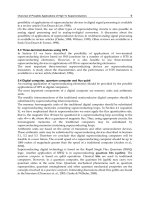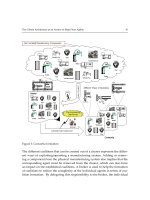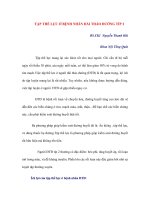The EQ interview finding employees high emotional intelligence part 2 potx
Bạn đang xem bản rút gọn của tài liệu. Xem và tải ngay bản đầy đủ của tài liệu tại đây (501.63 KB, 10 trang )
Behavior-based interviewing forms the fundamental theoretical
base for the questions in this book. Behavior-based interviewing ex-
amines past behavior and how that behavior contributes to a person’s
success. Behavior-based interviewing in a structured format has the
highest validity of all interviewing tools, according to a study by Ryan
and Tippins from Michigan State University.
7
Unfortunately, some man-
agers rely solely on the tools of gut instinct and chemistry to predict
a person’s effectiveness. We recommend behavior-based interviewing,
following a defined structure, and noting and rating answers based on
a Likert scale as the most useful methods for interviewing candidates.
We believe that these methods give the interviewer important data to
quantify gut instincts and overall impressions.
To gain an understanding of emotional intelligence, the inter-
viewer will examine the very nature of the behaviors that led to suc-
cessful results. We believe it is possible for a candidate to have very
successful results while at the same time wreaking havoc on peers or
others within the organization. The questions in this book examine
the behavioral consequences or impact of the successful results, not
just the results. For example, a line manager may have a great pro-
duction record in his unit, but may have accomplished this goal by ig-
noring the needs of peers and may in fact be blind to the goals of the
organization. Alternatively, long-term goals and results may be sacri-
ficed for short-term numbers.
It is also possible for certain behaviors to create a successful out-
come, yet not take into consideration the motives or intentions of the
candidate. Therefore, on many of the questions, the effective inter-
viewer or hiring manager will listen for the thought patterns that pre-
ceded and those that followed a particular behavior. This gives the
interviewer insights into the intentions behind the behavior as ex-
pressed by the candidate. The interviewer won’t be in the position of
making judgments about the candidate’s intentions, but instead will
be directed to listen to the facts about the candidate’s intentions as re-
ported in reflection by the candidate herself.
Candidates will also be directed to reflect on times when their
outcomes or results didn’t meet their intentions. By asking candidates
to reflect on their results, interviewers encourage candidates to reveal
behavior patterns that can dramatically affect teamwork, service ori-
entation, helpfulness, respectfulness, persistence, reaction to failure,
4 THE EQ INTERVIEW
resilience, and other important EQ competencies. This helps the in-
terviewer and hiring manager understand how candidates use past ex-
periences and integrate them into their current behavior.
INTRODUCTION 5
Endnotes
1. “Leadership IQ Study: Why New Hires Fail,” PR Newswire, September 20,
2005, 1.
2. Ellen Galinsky, “The Changing Landscape of Work,” Generations (Spring
2007): 7.
3. Chi-Sum Wong and Kenneth S. Law, “The Effects of Leader and Follower
Emotional Intelligence on Performance and Attitude: An Exploratory
Study,” Leadership Quarterly (June 2002): 243.
4. “Job Performance Linked to Personality,” Industrial Engineer 39, 7 (July 2007):
11.
5. V.U. Druskat, F. Sala, and G. Mount, eds., Linking Emotional Intelligence and
Performance at Work (Mahwah, NJ: Lawrence Erlbaum Associates, 2006).
6. Nancy Gardner, “Should I Stay or Should I Go? What Makes Employees
Voluntarily Leave or Keep Their Jobs,” University of Washington Office
of News and Information, July 26, 2007, hington
.edu/ni/article.asp?articleID=31234.
7. Ann Marie Ryan and Nancy T. Tippins, “Attracting and Selecting: What
Psychological Research Tells Us,” Human Resource Management 43, 4 (Win-
ter 2004): 305.
This page intentionally left blank
CHAPTER 2
The Five Areas
of Emotional Intelligence
and the EQ Job Competencies
7
Self-Awareness
and Self-Control
Empathy
Mastery of Purpose
and Vision
Social Expertness
Personal Influence
Inward OutwardInward
E
motional intelligence is defined as a person’s ability to manage
herself as well as her relationships with others so that she can live
her intentions. Very often, emotional intelligence is misunderstood.
In fact, many people think that emotional intelligence is equivalent
to social skills. Thinking that emotional intelligence is social skills,
however, is like thinking that a car is a steering wheel. This viewpoint
simply misses a huge part of the picture. Social skills are about our re-
lationship with the external world—how we interact with others. Of
course, those skills make up a part of the EQ competencies, but so much
of emotional intelligence is about our internal world. And it is our in-
ternal world that will drive how we interact with and respond to the
external world. Emotional intelligence, therefore, includes skills that
drive our internal world, as well as our response to the external world.
Our model for emotional intelligence contains five areas: self-
awareness and control, empathy for others, social expertness, personal
influence, and mastery of purpose.
1
Within the five areas, several spe-
cific competencies emerge. See Figure 2.1 and Appendix 1 for the Table
of Competencies. Definitions and competency descriptions of the five
areas are as follows:
1. Self-awareness and self-control comprise one’s ability to fully under-
stand oneself and to use that information to manage emotions
productively. This area includes the competencies of accurate un-
derstanding of one’s emotions and the impact emotions have on
performance, accurate assessment of strengths and weaknesses,
understanding one’s impact on others, and self-management or
self-control, including managing anger, disappointment, or failure
(resulting in resilience) and managing fear (resulting in courage).
2. Empathy is the ability to understand the perspective of others.
This area includes the competencies of listening to others, under-
standing others’ points of view, understanding how one’s words
and actions affect others, and wanting to be of service to others.
3. Social expertness is the ability to build genuine relationships and
bonds and express caring, concern, and conflict in healthy ways.
This area includes the competencies of building relationships, or-
ganizational savvy, collaboration, and conflict resolution.
4. Personal influence is the ability to positively lead and inspire oth-
ers as well as oneself. This area includes the competencies of lead-
ing others, creating a positive work climate, and getting results
from others. It also includes self-confidence, initiative and moti-
vation, optimism, and flexibility.
8 THE EQ INTERVIEW
5. Mastery of purpose and vision is the ability to bring authenticity to
one’s life and to live out one’s intentions and values. This area in-
cludes the competencies of understanding one’s purpose, taking
actions toward one’s purpose, and being authentic.
As you can see in the model depicted in Figure 2.1, three of the
components relate to our internal world (self-awareness and self-
control, empathy, and mastery of purpose and vision). The other two
form our relations to the external world (social expertness and per-
sonal influence). However, it is important to recognize that all are
interrelated, and one component builds on the next. Without self-
awareness and self-control, it is difficult, if not impossible, to improve
one’s relationship with the outside world. For example, if I am not
aware of my actions, thoughts, and words, I have no basis for self-un-
derstanding. If I have some awareness and self-understanding, then I
can ask, What is my impact on others, in my current state? If I find
that impact to be negative—if I find that it detracts from my life goals
—I may choose to change my actions, thoughts, or words. However,
some people look at themselves, understand that their actions, words,
or thoughts have a negative impact on others or detract from their life
goals, yet still either choose not to change or find change too difficult
to enact. In emotional intelligence, this change is what we call self-
control. It is about knowing ourselves, and then deciding the appro-
priate volume level and expression of our emotions. How do these
emotions enhance our relationships with others and our life goals,
and how do they detract from them? Self-awareness and self-control
are intertwined, as self-awareness alone is of little service without self-
control. Leaders, teammates, and others in the workplace are interde-
pendent, so it behooves everyone to improve self-understanding and
then to act upon this knowledge.
Beyond self-awareness and self-control is empathy, which is also
listed as an internal function on our model. Empathy must be felt in-
side before it can be reflected somehow in our relationships with peo-
ple in our external world. Therefore, empathy is a turning point or
transition in our emotional intelligence as it plays out in the outside
world. Also, without empathy, we are incapable of comprehending
the impact of our actions or words on others. We may have been told
THE FIVE AREAS OF EMOTIONAL INTELLIGENCE 9
that a particular behavior or word affects others in a negative way, but
empathy enables us to experience it. It also drives us to want to be
helpful or of service to others.
Next in our model is social expertness. Few of us can work or live
in isolation. People are generally a part of the equation. Social expert-
ness allows us to build genuine social bonds with others. It allows
us to know people in a way that is beyond knowing name, rank, and
serial number. It allows us to connect with them in an honorable
way. The best analogy I can offer is that it’s not about the number of
people in your Rolodex, but rather about the reaction those people
have when you’re on the other end of the phone. Are they delighted
that you called, or would they rather be talking to the long-distance
carrier trying to sell phone services? Beyond honorable social bonds,
social expertness calls on us to invite those within our social bonds
to collaborate in achieving our intentions. How well are we able to
collaborate with others and blend thoughts and ideas to achieve
goals or live intentions? But once we have invited people to collabo-
rate, conflict is inevitable, as different ideas will emerge. How will we
resolve those differences? Social expertness demands high levels of
conflict-resolution skills, which work to preserve social bonds and
trust. Social expertness also requires us to have organizational savvy
in order to move ideas and goals forward while maintaining positive
relationships.
Personal influence is the next area of our model for emotional in-
telligence. It also reflects our interactions with others. Personal influ-
ence is where true leadership emerges. Before this relationship stage,
we are peer to peer; it is here that we intend to influence others toward
goals or missions. However, we cannot influence others if we have not
created strong bonds or invited others to collaborate, or if we lack the
ability to resolve conflict in healthy ways. Leadership is not reserved
for positional leaders, however; all people are leaders. Even if we think
about leadership in terms of influencing our children, this area of emo-
tional intelligence is essential for a rich life and calls on us to influence
others. Equally important is our ability to influence ourselves. It is
within the walls of our own souls that the most work must be done. As
we influence ourselves to change, we can be an instrument of influ-
ence to others. Influencing ourselves requires our ability to take initia-
tive, stay motivated, display confidence and optimism, and be flexible.
10 THE EQ INTERVIEW
Finally, the model includes mastery of purpose and vision. It is the
most internally seated of all the aspects of emotional intelligence, and
it serves as a foundation on which to build a more emotionally intel-
ligent life. It is, in essence, both the reason we strive for emotional in-
telligence and the foundation that keeps us anchored. If we know
what our purpose is, it is much easier to determine what types of emo-
tional reactions will serve our purpose and what types will defeat it.
Therefore, understanding and managing emotions helps us to live our
life purpose. We place it last because it is sometimes the most difficult
to know and conceptualize. Although it is certainly possible to excel
in all other areas of emotional intelligence without yet discovering
true purpose, once true purpose is discovered, emotional intelligence
will be easier to improve.
THE FIVE AREAS OF EMOTIONAL INTELLIGENCE 11
FIGURE 2.1
Emotional Intelligence Table of Competencies
AREA OF EMOTIONAL
INTELLIGENCE DEFINITION COMPETENCIES
Self-Awareness and The ability to fully Self-Awareness
Self-Control understand oneself and • Impact on others:
one’s impact on others An accurate under-
and to use that standing of how
information to manage one’s behavior or
oneself productively words affect others
• Emotional and inner
awareness: An
accurate under-
standing of how
one’s emotions and
thoughts affect
behaviors
• Accurate self-
assessment: An
honest assessment
of strengths and
weaknesses
(continued)
FIGURE 2.1 Continued
AREA OF EMOTIONAL
INTELLIGENCE DEFINITION COMPETENCIES
Self-Control
• Emotional
expression: The
ability to manage
anger, stress,
excitement, and
frustration
• Courage: The ability
to manage fear
• Resilience: The ability
to manage disap-
pointment or failure
Empathy Ability to understand • Respectful listening:
the perspective of Listening respectfully
others to others to develop
a deep under-
standing of others’
points of view
• Feeling impact on
others: The ability to
assess and determine
how situations as well
as one’s words and
actions affect others
• Service orientation:
The desire to help
others
Social Expertness Ability to build genuine • Building relation-
relationships and bonds ships: The ability to
and express caring, build social bonds
concern, and conflict • Collaboration:
in healthy ways The ability to invite
12 THE EQ INTERVIEW
(continued)
FIGURE 2.1 Continued
AREA OF EMOTIONAL
INTELLIGENCE DEFINITION COMPETENCIES
others in and value
their thoughts
related to ideas,
projects, and work
• Conflict resolution:
The ability to resolve
differences
• Organizational savvy:
The ability to under-
stand and maneuver
within organizations
Personal Influence Ability to positively lead Influencing Others
and inspire others as • Leading others:
well as oneself The ability to have
others follow you
• Creating a positive
work climate: The
ability to create an
inspiring culture
• Getting results
through others: The
ability to achieve
goals through others
Influencing Self
• Self-confidence: An
appropriate belief in
one’s skills or abilities
• Initiative and account-
ability: Being inter-
nally guided to take
steps or actions and
taking responsibility
for those actions
THE FIVE AREAS OF EMOTIONAL INTELLIGENCE 13
(continued)









